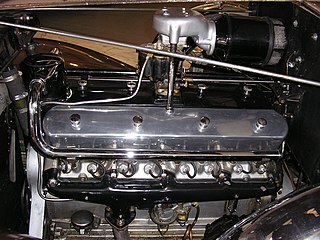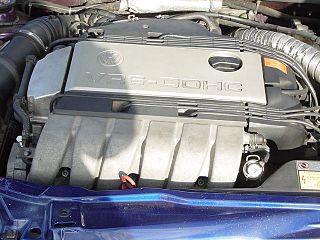
A V6 engine is a six-cylinder piston engine where the cylinders share a common crankshaft and are arranged in a V configuration.

The radial engine is a reciprocating type internal combustion engine configuration in which the cylinders "radiate" outward from a central crankcase like the spokes of a wheel. It resembles a stylized star when viewed from the front, and is called a "star engine" in some other languages.

A V16 engine is a sixteen-cylinder piston engine where two banks of eight cylinders are arranged in a V configuration around a common crankshaft. V16 engines are less common than engines with fewer cylinders, such as V8 and V12 engines. Each bank of a V16 engine can be thought of as a straight-eight, a design that can be inherently balanced. Most V16 engines have a 45° bank angle.
The engine configuration describes the fundamental operating principles by which internal combustion engines are categorized.

A W12 engine is a twelve-cylinder piston engine where either three banks of four cylinders, or four banks of three cylinders are arranged in a W configuration around a common crankshaft.

A W18 engine is an eighteen-cylinder piston engine with three banks of six cylinders in a W configuration.
A W8 engine is an eight-cylinder piston engine with four banks of two cylinders each, arranged in a W configuration.

The VR6 engine is a 6-cylinder engine configuration developed by VW. The name VR6 comes from the combination of German words “Verkürzt” and “Reihenmotor” meaning “shortened inline engine”. It was developed specifically for transverse engine installations and FWD vehicles. The VR6 is a highly compact engine, thanks to the narrower angle of 10.5 to 15-degrees between cylinder banks, as opposed to the traditional V6 angles ranging from 45 to 90-degrees. The compact design is cheaper to manufacture, since only one cylinder head is required for all 6 cylinders, much like a traditional inline-6 engine.

A W16 engine is a sixteen-cylinder piston engine with four banks of four cylinders in a W configuration.

A U engine is a piston engine made up of two separate straight engines placed side-by-side and coupled to a shared output shaft. When viewed from the front, the engine block resembles the letter "U".
A wasted spark system is a type of ignition system used in some four-stroke cycle internal combustion engines. In a wasted spark system, the spark plugs fire in pairs, with one plug in a cylinder on its compression stroke and the other plug in a cylinder on its exhaust stroke. The extra spark during the exhaust stroke has no effect and is thus "wasted". This design halves the number of components necessary in a typical ignition system, while the extra spark, against much reduced dielectric resistance, barely impacts the lifespan of modern ignition components. In a typical engine, it requires only about 2–3 kV to fire the cylinder on its exhaust stroke. The remaining coil energy is available to fire the spark plug in the cylinder on its compression stroke.
A V5 engine is a five-cylinder piston engine where the cylinders share a common crankshaft and are arranged in a V configuration.

The Chrysler A57 Multibank is a 30-cylinder 1,253 cu in (20.5 L) engine that was created in 1941 as America entered World War II. It consists of five banks of inline-6 cylinder engines.

In aviation, an inline engine is a reciprocating engine with banks of cylinders, one behind another, rather than rows of cylinders, with each bank having any number of cylinders, although more than six is uncommon. The major reciprocating-engine alternative configuration is the radial engine, where the cylinders are placed in a circular or "star" arrangement.

The V3 engine is a V engine with two cylinders in one bank and one cylinder in the other bank. It is a rare configuration, which has been mostly used in two-stroke engines for motorcycles competing in Grand Prix motorcycle racing.

The B5 version of the Volkswagen Passat, based on the Volkswagen Group B5 platform, was launched in 1997 in North America and Europe as well as during March 1998 in Australia.

The Bugatti W16 engine is a quad-turbocharged, W16 engine, under their high-performance luxury sports car marque Bugatti, since 2005.

Volkswagen Group have produced a number of W12 internal combustion piston engines for their Volkswagen, Audi, and Bentley marques, since 2001.
















